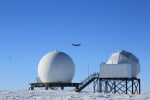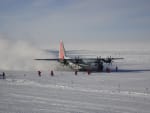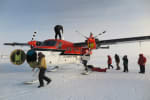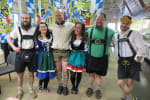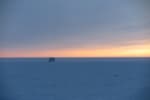There are training sessions for just about everything that goes on at the South Pole. Dropping cargo from an airplane is no exception. Last week, a C-17 performed the annual air drop training, shown here against a spectacular blue-sky backdrop just after releasing its cargo, which can be seen as a tiny speck off to the left, slowly parachuting to the ground […]
Life at the Pole
Week 45 at the Pole
A steady wind shows the flags at the ceremonial South Pole aligning themselves quite neatly. Flying conditions were good for most of the week, with several incoming flights bringing more summer visitors to the Pole, including the first IceCube team members to join the winterovers this season. […]
Week 44 at the Pole
Clear weather allowed most of the scheduled flights to make it to the Pole last week, with a stream of new arrivals from each plane. Inside the galley, the new summer crowd and the few remaining winterover staff do a good job of filling up the space. […]
Week 43 at the Pole
It’s that time of year for the “changing of the guard”—for IceCube’s winterovers, that is. Last week, Christian Krueger, one of IceCube’s 2015-16 winterovers, arrived alone and can be seen walking back from the plane alongside Stephan Richter, current winterover, who was on hand to greet him. […]
Week 42 at the Pole
IceCube winterover Stephan Richter took this wide angle shot of the South Pole station’s galley—in a completely empty state, not likely to found this way much longer since summer personnel will be arriving soon. The galley will be a bit busier with the expanded station population. […]
Week 41 at the Pole
The first planes of the season have arrived at the South Pole. Two planes landed last week, first a Basler (bearing gifts) and later a Twin Otter, shown in this image. […]
Week 40 at the Pole
The winterover crew gathered at the geographic South Pole for their annual group shot.
It was a relatively quiet week for the IceCube detector, but busy in general for the station. It’s that time of year, post sunrise, when preparations for summer arrivals are in full swing. […]
Week 39 at the Pole
The last thing you want to forget to pack when you’re off to the South Pole for a year is … your lederhosen. Afterall, Oktoberfest is among the many things that winterovering folks celebrate at the station. […]
Week 38 at the Pole
With the sun now up, outdoor preparations for summer activity at the South Pole station will move into higher gear. Calm weather last week provided an opportunity to groom the skiway, shown in this image, where the Earth’s shadow is still visible in the sky as a blue band just above the horizon. […]
Week 37 at the Pole
Sunrise is slowly coming along at the South Pole, with some refracted light showing over the horizon on clear days. The impending orange glow appears to be approaching the ICL in this image. […]
